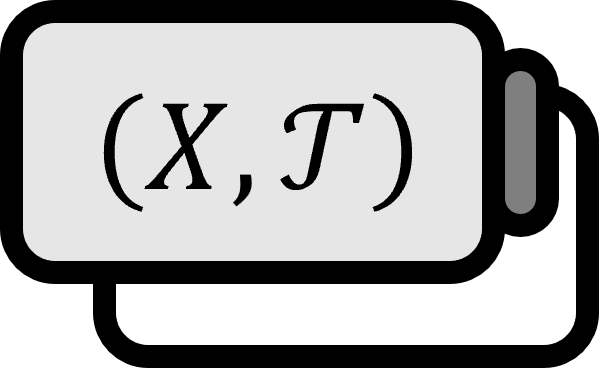Quotient Space
Definitions 1
Let’s say the quotient class for the topological space $(X, \mathscr{T} )$ and the equivalence relation $\sim$ is $[x] = \left\{ y \in X \ | \ x \sim y \right\}$.
- $X / \sim$ is defined as the quotient set.
- If $q : X \to X / \sim$ is defined as $q(x) = [ x ]$, it is called the quotient function.
- For $U \in \mathscr{T}$, $$ q^{-1} (U) = \bigcup_{[ x ] \in U} [ x ] \iff U \in \mathscr{T_{\sim}} $$ Let’s say. $\mathscr{T_{\sim}}$ is called the quotient topology, and $( X/ \sim , \mathscr{T_{\sim}} )$ is defined as the quotient space of $\sim$ for $X$.
- When $A \subset X$ is such that $x \sim y \iff x,y \in A$, $X / \sim$ can be represented as $X / A$.
Explanation
Since the equation is complex, one must approach it conceptually.
By ’treating’ two different points as ’essentially the same’ through an equivalence relation, concepts like ‘joining’ are mathematically defined. Here, the equivalence class becomes the ‘standard for treating as the same’, and a perfectly fine $X$ appears shattered into pieces as $X / \sim$.
Points unrelated to joining remain intact in $X$ even if shattered in $X / \sim$, but those related to joining become essentially the same point within $X / \sim$ as elements of the same equivalence class, making it irrelevant which point was which.
Understanding through the examples below is intuitive as long as one knows about set theory.
Examples
Line Segment → Circle

The quotient function $q : [0,1] \to [0,1] / \left\{ 0, 1 \right\}$ can essentially create a circle by treating both endpoints of the line segment as the same.
Square → Sphere

By gathering all edges of a square to a point, a sphere can be created. Imagine tying up a kerchief into a bundle.
Square → Cylinder → Torus

Rolling a square into a cylindrical shape, and then bending the cylinder to join its ends creates a torus.
Strip → Möbius Strip

As is well known, joining the ends of a strip in opposite directions introduces a twist in the middle, creating a Möbius strip without distinction between front and back.
Cylinder → Klein Bottle

Imagine joining the ends of a cylinder in the opposite direction. It seems impossible without damaging the cylinder but joining one end through and overlapping with the other end creates a Klein Bottle that lacks distinction between inside and outside.
Munkres. (2000). Topology(2nd Edition): p138. ↩︎
